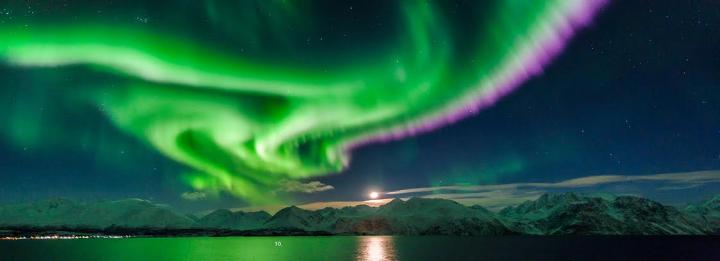Team led by graduate student at PPPL produces unique simulation of magnetic reconnection

Northern lights as seen over Norway. Credit: Jan R. Olsen
The new simulation captures the physics of magnetic reconnection, the breaking apart and snapping together of the magnetic field lines in plasma that occurs throughout the universe. The simulations approximate kinetic effects in a fluid code, which treats plasma as a flowing liquid, to create a more detailed picture of the reconnection process.
Previous simulations used fluid codes to produce simplified descriptions of reconnection that takes place in the vastness of space, where widely separated plasma particles rarely collide. However, this collisionless environment gives rise to kinetic effects on plasma behavior that fluid models cannot normally capture.
Estimation of kinetic behavior
The new simulation estimates kinetic behavior. “This is the first application of this particular fluid model in studying reconnection physics in space plasmas,” said Ng, lead author of the findings reported in August in the journal Physics of Plasmas.
Ng and coauthors approximated kinetic effects with a series of fluid equations based on plasma density, momentum and pressure. They concluded the process through a mathematical technique called “closure” that enabled them to describe the kinetic mixing of particles from non-local, or large-scale, regions. The type of closure involved was originally developed by PPPL physicist Greg Hammett and the late Rip Perkins in the context of fusion plasmas, making its application to the space plasma environment an example of fruitful cross-fertilization.
The completed results agreed better with kinetic models as compared with simulations produced by traditional fluid codes. The new simulations could extend understanding of reconnection to whole regions of space such as the magnetosphere, the magnetic field that surrounds the Earth, and provide a more comprehensive view of the universal process.
###
Coauthoring the paper were physicists Ammar Hakim of PPPL and Amitava Bhattacharjee, head of the Theory Department at PPPL and a professor of astrophysical sciences at Princeton University, together with physicists Adam Stanier and William Daughton of Los Alamos National Laboratory. Support for this work comes from the DOE Office of Science, the National Science Foundation and NASA. Computation was performed at the National Energy Research Scientific Computer Center, a DOE Office of Science User Facility, and the University of New Hampshire.
PPPL, on Princeton University's Forrestal Campus in Plainsboro, N.J., is devoted to creating new knowledge about the physics of plasmas — ultra-hot, charged gases — and to developing practical solutions for the creation of fusion energy. The Laboratory is managed by the University for the U.S. Department of Energy's Office of Science, which is the largest single supporter of basic research in the physical sciences in the United States, and is working to address some of the most pressing challenges of our time. For more information, please visit science.energy.gov.
Media Contact
All latest news from the category: Physics and Astronomy
This area deals with the fundamental laws and building blocks of nature and how they interact, the properties and the behavior of matter, and research into space and time and their structures.
innovations-report provides in-depth reports and articles on subjects such as astrophysics, laser technologies, nuclear, quantum, particle and solid-state physics, nanotechnologies, planetary research and findings (Mars, Venus) and developments related to the Hubble Telescope.
Newest articles

A ‘language’ for ML models to predict nanopore properties
A large number of 2D materials like graphene can have nanopores – small holes formed by missing atoms through which foreign substances can pass. The properties of these nanopores dictate many…

Clinically validated, wearable ultrasound patch
… for continuous blood pressure monitoring. A team of researchers at the University of California San Diego has developed a new and improved wearable ultrasound patch for continuous and noninvasive…

A new puzzle piece for string theory research
Dr. Ksenia Fedosova from the Cluster of Excellence Mathematics Münster, along with an international research team, has proven a conjecture in string theory that physicists had proposed regarding certain equations….



